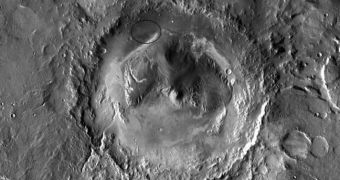On July 22, NASA announced that it decided to send the Mars Science Laboratory (MSL) rover Curiosity to Gale Crater. This Martian impact structure is the most relevant location to conduct the type of science Curiosity was created for, and an MIT expert recently explained why.
The best way to describe this crater is a massive, 154-kilometer [96-mile] depression that features a very large, finely-stratified mountain at its center. It’s the presence of this formation that eventually persuaded panel members to send the rover here.
Once it arrives on Mars, the machine will spend at least two years sampling the area, collecting rocks and zapping away with its onboard laser at stony formations. Its analysis need to determine whether the Red Planet is, or ever was, habitable.
But what researchers are mostly interested in is learning more about the nature of Mars’ past climate, says the Earle A. Griswold Professor of Geophysics and Planetary Science, Maria Zuber. She is also the head of the Department of Earth, Atmospheric and Planetary Sciences at MIT.
“Gale is a large, ancient crater in the equatorial region of Mars that formed somewhere in the range of 3.5 to 3.8 billion years ago. At the center of the crater is a five-kilometer-high mountain that contains hundreds of fine layers and grades in composition from the bottom up,” she says.
“Such a sequence of rocks, called a stratigraphic section, is a treasure trove of information for geologists. It preserves a temporal record, in which you're essentially looking back in time as you progress down the column,” the expert adds.
Geologists agree that the mountain at the core of Gale Crater formed from sediments that at one time filled the entire structure. Over time, they eroded, leaving only this tall structure standing.
The base of the mountain itself is made up of clays, chemicals that only form if large amounts of water are present in the environment. “The geologic context of the clay minerals will hopefully allow the origin to be distinguished,” Zuber explains.
“Gale has had a complex history but it seems certain that water played a role in shaping the crater. There may have been a large amount of water on the floor, and water may have played a role in depositing the sediments that compose the central mountain,” she adds.
In addition to the actual science it will conduct on the Red Planet, Curiosity will also demonstrate that it is possible to place a large, heavy spacecraft on the surface of another planet.
This will be very important in the 2030s, when NASA plans to send humans on the planet, either to study it, or to establish a permanent colony.

 14 DAY TRIAL //
14 DAY TRIAL //